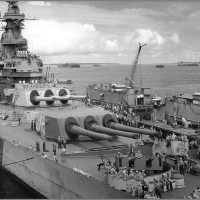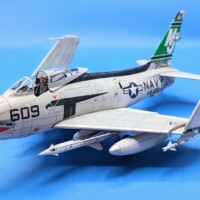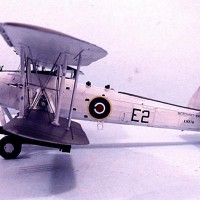Crow's Nest Mercury Spacecraft
On May 5, 1961, Alan Shepard sat in a glorified garbage can atop a converted ballistic missile and was lofted 263 miles from Cape Canaveral, FL to the North Atlantic just off the Bahamas. He sat in the cramped capsule for 4 hours before the mission finally launched: a series of unplanned holds kept the rocket on the ground, and only Shepard urinating on himself finally moved things along.
Shepard was the first American in space, beaten by the USSR's Yuri Gagarin some three weeks prior, apparently because we decided to send a chimpanzee up beforehand.
The Kit
This is the 1/32-scale Crow's Nest/Accurate Models Mercury capsule, porthole version (appropriate to Shepard's Freedom 7, the so-called MR-3 mission). I possibly purchased the last one in existence back in 2022 some time; it's very hard to find. There is one other 1/32-scale Mercury kit that I'm aware of, by Raccoon Models which is also very rare (in Summer 2024 there is one kit on eBay selling for around $200).
The completed 1/32 Mercury capsule ends up being about the size (and shape) of a pear:
The kit is primarily cast resin, with some PE, wire, and white metal adornments.
The instructions (all 30 pages) are a labor of love: the designers of this kit cared the utmost for accuracy, and recommend little tricks throughout to make the model really stand-out (e.g. shave off some pencil graphite and dust it onto the finished capsule to give it a subtle metallic sheen!)
Oddly, the instructions provide accurate decal placement only for the window-version capsule (missions MR-4 onwards), and specifically show the MA-8 version. We even get decals for all the different versions, but we simply can't make any of these others because we only have the porthole version of the capsule, which was only used for MR-3. Which makes one wonder why there need be two whole separate kits here: providing an additional part or two so that the capsule can be converted between window and porthole versions seems like an obvious selling point. Anyway, the lack of detailed instructions (decals, colors) for MR-3 requires one to scrounge around for marking documents and photographs.
I was bummed to discover upon laying out all the parts that I was missing the retropack module (it is strapped to the heat shield and contains the parachutes). This is unfortunate, because it's an important part if one is interested in building the spacecraft in its "starting" configuration. I considered several options: hunt specifically for a replacement part being sold second-hand on the internet. Chances virtually nil. I have Atomic City's 1/12-scale Mercury capsule kit: couldn't I use the retro pack from that kit as a (larger-scale) template to 3D print a 1/32-scale part? I would only need a 3D printer with which to scan the part! Well, these cost like $10K, so that's out. Then it occurred to me to simply try and reach out to Crow's Nest directly. I did some more digging online and came across the Facebook page of Jim Key from Accurate Models. His latest post was from 2021 some time, but I figured I'd drop him a line. "Hey, any chance you've got a spare retro pack rattling around in your glove compartment?" Well, Jim got back to me almost immediately and said that he did, in fact, have an early casting of the part. He asked me a couple questions about the version of kit I was building and told me that my particular kit, the one with the white metal escape tower, is all wrong and that Accurate Models had a newer release with updated, crisply 3D-printed parts. He offered to print off a few of these parts and sell them to me at cost so that I could "build the best version of this kit." Serendipity.
Now, on to the build.
Most of the effort goes into the interior of the capsule, which is nicely detailed. Some craft wire is provided for electrical conduits and such, though I supplemented with some smaller gauge wire to better simulate the smaller connectors. The instructions give us some advice and suggestions here, but I also relied on the stunning work of Phil Smith for cockpit details. Some cardboard was used for the seat backing, and 1/32-scale seatbelts from Eduard's USN set were used.
The control panel is also highly detailed, and we are to add the individual avionics "cans" to the back of the panel along with a bunch of wiring.
The finished control panel fits snugly into the interior, along with a few other adornments:
Now the rub is that after all this, though the finished model can be displayed with the capsule door open to reveal the inside, much of the detail is greatly obscured. There are instructions for the installation of LED lights to illuminate the interior, but no such set came with my (used) kit. While I could probably improvise here, I don't like the idea of permanently mounting the capsule to its stand, which would be needed to conceal the wiring.
And so I sealed everything up, much like closing the canopy on a tricked-out, aftermarket boosted 1/72-scale Tamiya or Eduard cockpit. From the outside, some wiring is visible but not much else:
The paint scheme for MR-3 calls for black capsule exterior, gray heat shield, and aluminum retropack. The escape tower is red. After a base coat of Tamiya black, it's time for decals. These are nice and thin, which is good since they need to conform to the corrugated exterior. Even with Solvaset, one really can't get them to settle in perfectly and it is necessary to make little cuts in the decal to prevent silvering. Next, I applied a light gray enamel wash to add some highlights to the capsule exterior. This weathering ended up looking rather striking, and I'm afraid it might be more pertinent to a used capsule than a new one.
The retropack was painted with Alclad Aluminum, and the PE straps with Alclad Steel. The retropack was given a light wash of black and dark gray panel liner for contrast and to dull it down a bit. (Photographs of retropacks emblazoned with the fancy black striping are for later missions). While the capsule was finished with matte varnish, the heat shield was given semi-matte to recreate the slightly shiny finish of the real thing. The escape tower was given a black enamel wash and then finished with semi-gloss varnish.
A black tilted stand is included, but I prefer clear acrylic. In fact, it stands up perfectly fine on its own, balancing easily on its retropack. This was an involved build to say the least, but fun and worthwhile.














Excellent model. The 1/48 RM kit is tiny. 1/32 might (like WW1 aircraft) be the best scale to see the fine details as opposed to the 1/12 Atomic City kit.
Thanks! Yeah I settled on 1/32 because I want to build the Mercury/Gemini/Apollo series in the same scale. I want good detail across all scales (so 1/48 too small for Mercury) while being not massive (1/12 way too big for Apollo). Plus there actually are 1/32-scale offerings of each.
Looks great, nicely done!
Thank you Robert!
Congratulations, Brian! Fantastic result!
1/32 is indeed the best scale for this subject.
Loved reading your article, as well!
Thanks Spiros! Yeah, while the 1/12-scale Mercury is nice and roomy, it's quite large and apparently the detail does not really meet expectations for the scale.
He didn't "threaten" to urinate. He urinated. And proved the engineers were carrying their heads in that well-known head receptacle down between their legs.
Nice work on this and a super result.
Thanks Tom. Corrected!
That's an amazing result, Brian @bapowellphys
It must have been a pleasure to go through all those 30 pages of instructions.
Well done.
Very nice work on the Mercury, Brian (@bapowellphys). It was a fascinating time in space light history. And I agree, 1/32 is the scale of choice here. Thanks for sharing.
Great job, Brian. Looks like a nice detailed kit.
Thanks Gary! It was!
Super job
Great Work Brian, @bapowellphys. That is really a good looking job, and I wouldn't worry about the wash, it worked. Part of the purpose of a wash is to force shadows and enhance texture a bit. It brings the viewer into the build and helps to make you feel like you are looking at it up close instead of the scale view of 50ft where the detail isn't really viewable. Remember even from just a foot away your are scale viewing it from 32 ft.
Good points, Walt. Accounting for scale effect is something I’ve really only recently been aware of.
What a great project! I feel for you for having to make most of that lovely detail work disappear - such is the life of a modeler! At least we have pics (and you have memories)!
Thanks, Greg! My sentiments exactly!
This is one heck of a build Brian! It sure has a ton of details put into this and it looks great too. This was an amazing time during the history of Space.
I was in 4th grade and all the kids in my school were crowded into the cafeteria around small black and white TVs to watch this launch. You could see almost nothing. The wait was so long that some of the bigger kids (6th graders) started acting out and had to go back to their class rooms.
Your model is great and brings back memories of a long gone time. Well done.